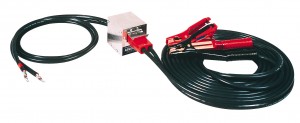There are two approaches I've seen used for EVs and PHEVs in this sort of situation.
The simplest is a 12V inverter - hooked in to the car's 12V systems, it creates a small amount of AC electricity to run a single fridge and charge cell phones and the like. Those you can buy off the shelf from Amazon and the like and connect yourself. This means all of the power for the inverter is running through the car's DC-DC converter, and that often limits the power available. For my Volt, GM published specs that said it was a 2kW/175A device, so I felt reasonably safe with a 1kW inverter (remember, the car has to be on so the DC-DC will run and you don't kill the 12V, and so the car's systems need some level of power.)
Tesla hasn't published the limits of the DC-DC converter for the S/X that I've seen (who knows if the 3 will get the same capacity,) and I haven't read of anyone doing testing on its limits. The small 12V complicates matters, because a relatively short period of overdraw might drain it, which would shut the car down until it can be jumped with 12V power.
The other approach is something marketed commercially in Japan, though I haven't seen them for sale here. Japanese companies sell an inverter connected to a CHAdeMO connector, which draws high voltage DC directly from the pack on a Leaf, Outlander, or Mirai (the only reason a Mirai has a CHAdeMO connector...) This of course eliminates the stress on the DC-DC converter and the limitations from there, and there's no need to mess with wiring. It's a safer, more efficient, more capable (and undoubtedly more expensive) solution.
In principle, if one could acquire it, one could hook one of these devices to the Tesla CHAdeMO adapter and plug that into the car. I'm sure all the parts will fit and connect electrically. I'm not sure what would happen when it was turned on - I don't know if the car has code to keep power from being drained that way, or if the other cars require explicit code to control how the drain is handled. I don't think there's any risk of anything breaking or any safety hazard, but I wouldn't place a bet on whether you'd get power out.





